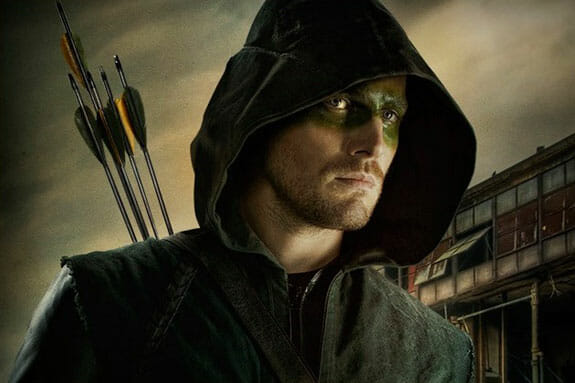With the debut of Arrow last October, the CW finally found themselves in possession of a hit show that does not involve demon-hunting siblings or sexually charismatic vampires and the diary-obsessed teenage girls who love them.
Billed as a superhero series in the vein of Smallville, Arrow trades in the reverent Superman mythos for the more down-and-dirty street fighting of the Green Arrow comic universe, repackaging it as a sleek, action-packed adventure drama with sharp dialogue and plenty of sex appeal via frequent shots of Stephen Amell’s toned abs.
What could easily have been a cheap cash-in that shamelessly pandered to the ongoing superhero trend instead become, in the hands of veteran TV writers Greg Berlanti, Andrew Kreisberg and Marc Guggenheim, an energizing slice of superhero pulp fiction that garnered mass appeal while never failing to tip its hat to the funny books that inspired it. With a few rocky spots here and there, the Arrow’s first season built upon a central mystery involving Oliver’s shady family that brilliantly crescendoed in an explosive finale.
With “City of Heroes,” the creative team has hit the ground running, delivering a fast-paced premiere sure to placate anyone who feared a sophomore nosedive in quality.
In traditional Arrow fashion, we’re barely a few seconds into the episode before we get a glimpse of Oliver Queen shirtless. He’s running frantically through what looks to be the island where he spent five years training to become the green-clad ninja he is today. Any notions of this being a flashback, however, are dispelled the moment we see his crime-fighting partners Diggle and (a very anxious) Felicity parachuting into the area.
Turns out, this is indeed the island where Oliver spent those lost years of his life. In a scene that feels very much like the first act of every ‘80s action movie ever made, Diggle and Felicity attempt to cajole our reluctant protagonist out of his reclusive lifestyle and return to what he does best: beating up bad guys and keeping the streets clean.
To Oliver’s credit, his reasons for defecting are more than understandable. Under his watch, a large portion of the city and thousands of lives were lost in a man-made earthquake caused by last year’s Big Bad Malcolm Merlyn. Included among the dearly departed was Oliver’s best friend/Malcolm’s son Tommy, who died heroically saving his ex-girlfriend Laurel (who served as both mens’ object of desire in last season’s love triangle) from a collapsing building. That Tommy went to his grave calling Oliver a murdering vigilante eats our protagonist up inside.
Eventually, Diggle and Felicity ultimately succeed in their coercion and Oliver returns to a demolished Starling City. Naturally, his arrival coincides with the mayor’s assassination. The perpetrators are a quartet of gun-wielding vigilantes who have modeled their look and dogma after Oliver’s “Hood” character.
In a premiere episode filled to the brim with subplots as well as seeding for future plotlines, this confrontation between Oliver and his evil doppelgängers offers up a visual illustration of the series’ new status quo. Placed before adversaries that reflect a darker extension of his former persona, Oliver must face down his past sins and determine what kind of hero he truly wants to be. This means retiring the “Hood” mantle and adopting an identity with a far more stringent moral compass. Though the episode cuts out before Oliver can voice what he wants to be called, the fact that the final shot shows him gazing at one of his green arrows is a cheeky nod to what his answer may be.
Of course, there’s a lot more to the episode, including the requisite flashback scenes. While the first season’s reoccurring flashbacks to Oliver’s time on the island could be a tad hit-and-miss, this week’s—concerning Shado’s abduction by a new island adversary—manages to be sufficiently short and non-intrusive while still doing a great job of paralleling the episode’s main themes. Plus, Amell is never more endearing than when he gets to ditch Oliver’s stoic, brooding demeanor and play his immature, goofier former self.
One potential issue that the show appears to be carrying over from its previous season concerns how the writers employ Oliver’s sister, Thea. In a season filled with non-stop action and the kind of melodramatic family drama worthy of Dynasty, the misadventures of a troubled teenage girl often proved to be a bit of a momentum-killer in some of the early episodes.
Although the writers later found ways of incorporating Thea into storylines that felt a touch more organic, the character—as well as her relationship with Roy Harper—still feels like a blatant attempt at reflecting the typical CW age demographic. And, yes, I know Roy (supposedly) becomes Green Arrow’s sidekick Speedy/Arsenal down the line (his red hoodie attire is quite an on-the-nose detail), but their scenes add up to one plot too many. That being said, Thea’s scene with her imprisoned mother helps show that actress Willa Holland has range beyond simply playing the angsty, yet sassy teen.
Also new to the show’s universe is Isabel Rochev as a ruthless businesswoman looking to overtake the Queen’s dismantled company. Those savvy in recent comic book lore know very well that Rochev holds a special place in the Green Arrow mythology. How closely the show will mirror her arc in the comic remains to be seen.
“City of Hope” successfully sets a top-notch standard for the new season and expertly builds off the momentum and good will the show earned from last year’s dynamite conclusion. Here’s hoping for many more quality hours of Oliver kicking ass and taking names (presumably, without his shirt off).
